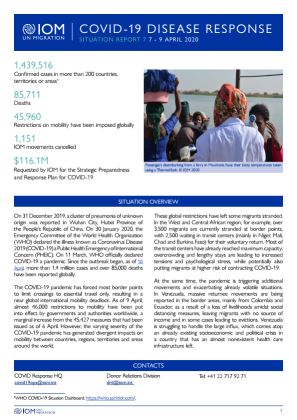-
Countries
-
Data and Analysis
-
Special Focus
-
Crisis Responses
Covid 19 Disease Response - Situation Report 7 (7 - 9 April 2020)

Contacter
COVID Response HQ covid19ops@iom.int
Langue
English
Emplacement
Global
Période couverte
Apr 07 2020
Apr 09 2020
Activité
- Other
On 31 December 2019, a cluster of pneumonia of unknown origin was reported in Wuhan City, Hubei Province of the People’s Republic of China. On 30 January 2020, the Emergency Committee of the World Health Organization (WHO) declared the illness known as Coronavirus Disease 2019 (COVID-19) a Public Health Emergency of International Concern (PHEIC). On 11 March, WHO officially declared COVID-19 a pandemic. Since the outbreak began, as of 10 April, more than 1.4 million cases and over 85,000 deaths have been reported globally. The COVID-19 pandemic has forced most border points to limit crossings to essential travel only, resulting in a near global international mobility deadlock. As of 9 April, almost 46,000 restrictions to mobility have been put into effect by governments and authorities worldwide, a marginal increase from the 45,427 measures that had been issued as of 6 April. However, the varying severity of the COVID-19 pandemic has generated divergent impacts on mobility between countries, regions, territories and areas around the world. These global restrictions have left some migrants stranded. In the West and Central African region, for example, over 3,500 migrants are currently stranded at border points, with 2,500 waiting in transit centers (mainly in Niger, Mali, Chad and Burkina Faso) for their voluntary return. Most of the transit centers have already reached maximum capacity; overcrowding and lengthy stays are leading to increased tensions and psychological stress, while potentially also putting migrants at higher risk of contracting COVID-19. At the same time, the pandemic is triggering additional movements and exacerbating already volatile situations. In Venezuela, massive returnee movements are being reported in the border areas, mainly from Colombia and Ecuador, as a result of a loss of livelihoods amidst social distancing measures, leaving migrants with no source of income and in some cases leading to evictions. Venezuela is struggling to handle the large influx, which comes atop an already existing socioeconomic and political crisis in a country that has an almost nonexistent health care infrastructure left.
